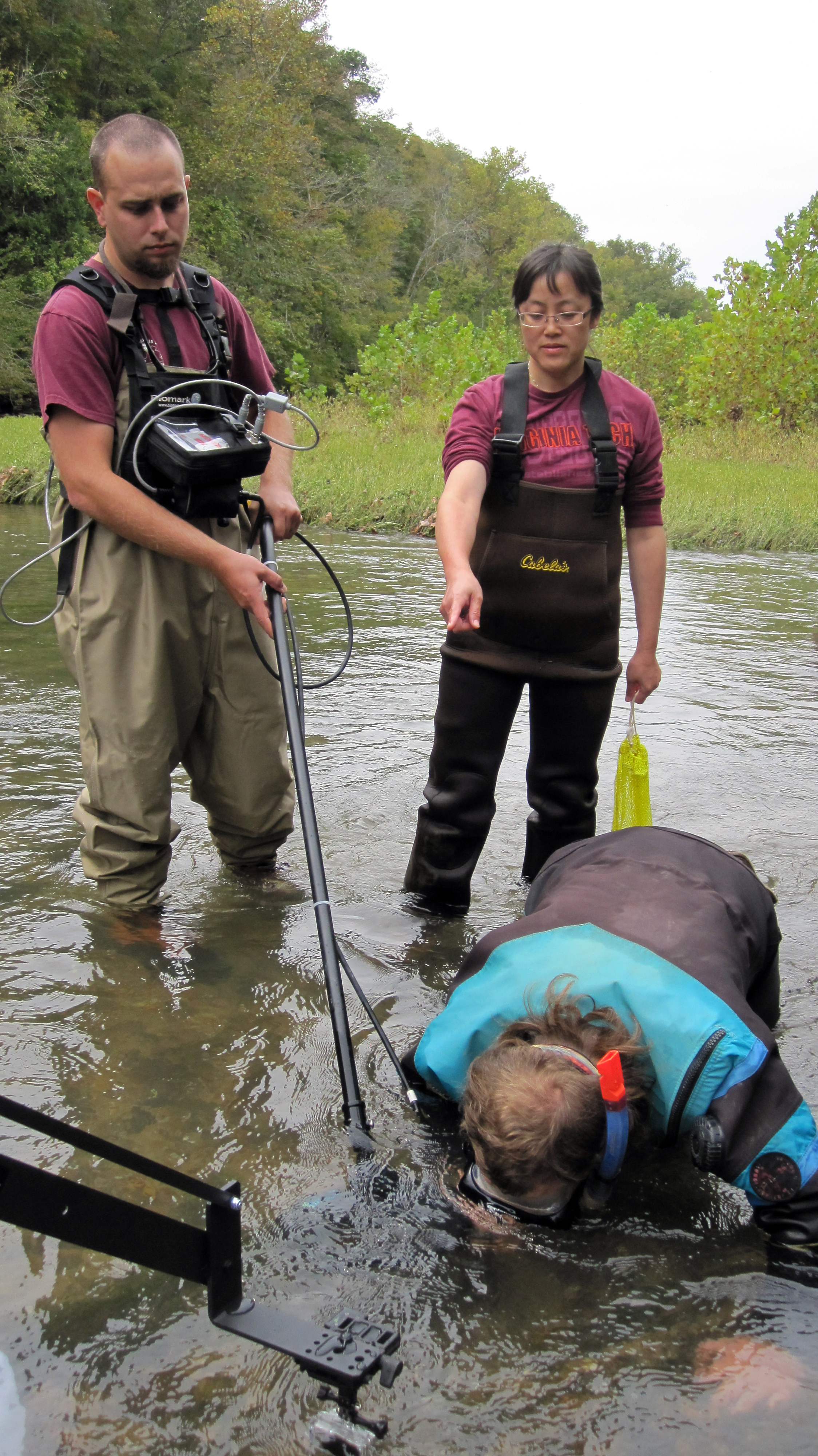Partners collaborate on largest release of endangered mussels in Powell River

This fall Virginia Tech’s Freshwater Mollusk Conservation Center, in partnership with Lincoln Memorial University in Harrogate, Tenn.; the Tennessee Wildlife Resources Agency; and the U.S. Fish and Wildlife Service, released 7,086 juvenile mussels into the Powell River, the largest number of endangered mussels planted in the history of the river restoration project.
The one-year-old mussels were propagated and raised at the mollusk center a cooperative research and propagation facility to restore and recover endangered freshwater mollusks (basically shell-covered invertebrates) in Virginia and adjacent states.
Jess Jones, restoration biologist with the U.S. Fish and Wildlife Service in Virginia Tech’s College of Natural Resources and Environment and director of the mollusk center, coordinated the release, which included a public demonstration day involving students from both universities. Lincoln Memorial University’s Powell River Aquatic Research Station in Claiborne, County, Tenn., served as the headquarters for the event.
A combined total of 6,086 oyster mussels, 1,000 combshell mussels, and 27 snuffbox mussels were released upstream and downstream of the Powell River Brooks Bridge on Tennessee State Route 63 near the Virginia line and at other nearby sites in the river. All three species are listed as federally endangered.
The release is part of ongoing efforts to revitalize the Powell River, which begins in rural Wise County, Va., and flows into East Tennessee before its confluence with the Clinch River, another river originating in Southwest Virginia, at Tennessee’s Norris Lake reservoir, which empties into the Tennessee River.
The U.S. Environmental Protection Agency has designated the Powell River, which has been under pressure from the effects of mining, logging, and other activities, as one of the most biologically diverse aquatic systems in the nation. Nearly 100 fish species and 35 mussel species occur in the river.
Mussels, which act as filters to purify the waters, have declined significantly in the river, which is why the restoration efforts are taking place. Researchers have found that by planting masses of mussels in suitable riverbed habitats, the mussels have the greatest chance of survival. They go on not only to clean up dying rivers but also to help rebuild the chain of life for other fisheries and wildlife in the ecosystem.
“In partnership with Lincoln Memorial, we have geospatially mapped the river, so we know where the shallow shoals with gentle river flows are. These are the ideal places for planting the juvenile mussels,” Jones explained. “This area of the Powell is one of the few free-flowing sections of the river in the Tennessee River valley, which also helps make this site good for recovery efforts.”
“Each juvenile mussel has a number glued on its shell, and some are implanted with a tracking device that we can use to locate them later,” Jones continued. “We do follow-up population counts and have been seeing a 90-percent survival rate based on results obtained by the mollusk center’s lab manager Dan Hua,” of Blacksburg, Va., a Ph.D. student who is studying mussel survival in the College of Natural Resources and Environment’s Department of Fish and Wildlife Conservation.
Because mussels are sensitive to water pollution, they are a good indicator of river health. One adult mussel can filter 10 to 50 gallons of water a day — mussels are one of nature’s most effective ways to clean up and restore life to rivers that are no longer pristine.
“The biggest goal of this project is to revitalize the Powell River and get it back to healthier times,” said Ronald Caldwell, professor of biology and director of the Cumberland Mountain Research Center at Lincoln Memorial. “In the process, we are trying to save endangered species and give our students a one-of-a-kind learning experience.”
The Powell River, home to 13 mussel species listed as federally endangered, has the second highest concentration of rare and endangered mussels in the nation. Researchers at Virginia Tech’s Freshwater Mollusk Conservation Center studied mussel species for many years to identify their life and reproductive cycles. They then experimented with propagating endangered species so they could grow and plant these species in the rivers where they were native and once flourished.
Researchers will continue mussel stocking efforts at the Powell River near the Brooks Bridge and other sites for the next two years, along with monitoring and tracking the success rate, with the goal of establishing a self-sustaining population of each species in the river. Other partners in the project include the Virginia Department of Game and Inland Fisheries and The Nature Conservancy.
The collaborative partnership has led to land purchases to protect riparian habitat along the banks of the Powell River, research to improve mussel propagation technology, and the rearing of baby mussels at Virginia Tech’s mollusk center and at the Department of Games and Inland Fisheries’ Aquatic Wildlife Conservation Center near Marion, Va. Both facilities contribute endangered mussels for stocking at sites in the Powell and Clinch Rivers in Tennessee and Virginia.
Virginia Tech’s mussel restoration techniques serve as a model and are being replicated by fisheries agencies in other parts of the country. Each year the mollusk center propagates a total over 10,000 mussels of six to 10 species for release. Every mussel is tagged, sexed, and measured, and the data is recorded for future monitoring.




